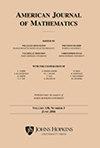A necessary and sufficient condition for the Darboux-Treibich-Verdier potential with its spectrum contained in ℝ
IF 1.7
1区 数学
Q1 MATHEMATICS
引用次数: 0
Abstract
abstract:In this paper, we study the spectrum of the complex Hill operator $L={d^2\over dx^2}+q(x;\tau)$ in $L^2(\Bbb{R},\Bbb{C})$ with the Darboux-Treibich-Verdier potential $$ q(x;\tau):=-\sum_{k=0}^{3}n_{k}(n_{k}+1)\wp\left(x+z_0+{\omega_k\over 2};\tau\right), $$ where $n_k\in\Bbb{Z}_{\geq 0}$ with $\max n_k\geq 1$ and $z_0\in\Bbb{C}$ is chosen such that $q(x;\tau)$ has no singularities on $\Bbb{R}$. For any fixed $\tau\in i\Bbb{R}_{>0}$, we give a necessary and sufficient condition on $(n_0,n_1,n_2,n_3)$ to guarantee that the spectrum $\sigma(L)$ is $$ \sigma(L)=\big(-\infty, E_{2g}\big]\cup\big[E_{2g-1},E_{2g-2}\big]\cup\cdots\cup[E_1,E_0],\quad E_j\in\Bbb{R}, $$ and hence generalizes Ince's remarkable result in 1940 for the Lam\'{e} potential to the Darboux-Treibich-Verdier potential. We also determine the number of (anti)periodic eigenvalues in each bounded interval $(E_{2j-1},E_{2j-2})$, which generalizes the recent result by Haese-Hill et al., who studied the Lam\'{e} case $n_1=n_2=n_3=0$.Darboux-Treibich—Verdier势的一个充要条件ℝ
文摘:在本文中,我们研究了复Hill算子$L={d^2在dx^2}+q(x;\tau)$L^2(\bb{R},\bb{C})$中的谱,该算子具有Darboux-Treibch-Verdier势$q(x,\tau):=-\sum_{k=0}^{3}n_{k} (n_{k}+1)\wp\left(x+z_0+{\omega_k\over 2};\tau\right),$$其中$n_k\in\Bbb{Z}_{\geq 0}$与$\max n_k\geq 1$和$z_0\in\Bbb{C}$被选择为使得$q(x;\tau)$在$\Bbb{R}$上没有奇点。对于i \Bbb中的任何固定$\tau\{R}_{>0}$,我们给出了$(n_0,n_1,n_2,n_3)$上的一个充要条件,以保证谱$\sigma(L)$是$$\sigm(L)=\big(-\infty,E_{2g}\big)\cup \big[E{2g-1},E_{2g-2}\big]\cup \cdots\cup[E_1,E_0],\quad E_j\in\Bbb{R},$$,并由此将Ince在1940年关于Lam{E}势的显著结果推广到Darboux-Treibch-Verdier势。(反)每个有界区间$(E_{2j-1},E_{2j-2})$中的周期特征值,这推广了Haese-Hill等人最近研究Lam情况$n_1=n2=n_3=0$的结果。
本文章由计算机程序翻译,如有差异,请以英文原文为准。
求助全文
约1分钟内获得全文
求助全文
来源期刊
CiteScore
3.20
自引率
0.00%
发文量
35
审稿时长
24 months
期刊介绍:
The oldest mathematics journal in the Western Hemisphere in continuous publication, the American Journal of Mathematics ranks as one of the most respected and celebrated journals in its field. Published since 1878, the Journal has earned its reputation by presenting pioneering mathematical papers. It does not specialize, but instead publishes articles of broad appeal covering the major areas of contemporary mathematics. The American Journal of Mathematics is used as a basic reference work in academic libraries, both in the United States and abroad.

 求助内容:
求助内容: 应助结果提醒方式:
应助结果提醒方式:


